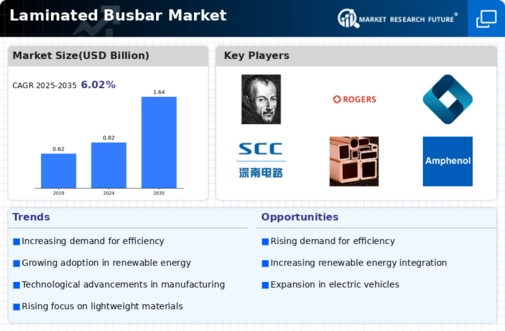Top Industry Leaders in the Laminated Busbar Market

*Disclaimer: List of key companies in no particular order
Latest Company Updates:
The laminated busbar market is a dynamic space experiencing steady growth, fueled by the rising demand for efficient and compact power distribution solutions. This growth has attracted a range of established and emerging players, leading to a competitive landscape with diverse strategies and evolving trends.
Key Players & Their Strategies:
Global Giants: Renowned companies like Rogers Corporation (US), Amphenol Corporation (US), and Mersen (France) leverage their extensive technical expertise and established distribution networks to cater to large-scale projects in utilities and industrial sectors. These players emphasize product innovation, focusing on advancements in insulation materials and conductor optimization to enhance safety and performance.
Regional Specialists: Companies like Sun King Power Electronics (China) and Fuji Electric (Japan) excel in specific regional markets through localized product offerings and cost-competitive strategies. They cater to unique application requirements and build strong relationships with regional contractors and OEMs to gain an edge.
Emerging Innovators: Start-ups and smaller players are entering the market with disruptive technologies and niche solutions. For example, companies like Elascon (Italy) are pioneering the use of composite materials in busbars, offering enhanced flexibility and weight reduction. These innovators often target specific end-user segments like residential solar installations or electric vehicle charging infrastructure.
Market Share Analysis Factors:
Technology & Innovation: Companies with advanced in-house research and development capabilities and a strong focus on patent protection hold an advantage. Technological advancements in insulation materials, conductor design, and smart integration features can attract premium customers and boost market share.
Production Capacity & Cost-Effectiveness: Efficient production processes, optimized material sourcing, and robust supply chains are crucial for cost competitiveness. Players with vertically integrated operations and a global manufacturing footprint can offer competitive pricing and secure larger volume contracts.
Brand Reputation & Customer Relationships: Established brands with a proven track record and strong customer relationships maintain an edge in the market. Building trust through reliable performance, responsive service, and technical expertise helps acquire and retain customers.
Regional Focus & Market Penetration: Understanding the specific requirements and regulations of different regions is key. Players with localized production facilities, partnerships with regional distributors, and customized product offerings can effectively penetrate specific markets and gain market share.
New & Emerging Trends:
Sustainability & Eco-Friendly Materials: The increasing focus on environmental responsibility is driving demand for laminated busbars made from recycled materials and bio-based resins. Additionally, innovations in energy-efficient designs and smart monitoring systems further contribute to this trend.
Integration with Smart Grid Technologies: The growing adoption of smart grids necessitates busbars equipped with sensors and communication capabilities. Players are developing intelligent busbar systems that offer real-time data on power usage, enabling predictive maintenance and improved grid efficiency.
Miniaturization & Compact Designs: With space constraints becoming increasingly important, the demand for compact and lightweight busbars is rising. Advances in conductor materials and insulation technology allow for smaller busbar footprints without compromising performance, catering to applications with limited space availability.
Overall Competitive Scenario:
The laminated busbar market is witnessing a dynamic interplay between established players, regional specialists, and emerging innovators. While larger companies leverage their brand reputation and technical expertise, smaller players are carving niches through technological advancements and cost-effective solutions. The market is further evolving with the integration of smart grid technologies and the emphasis on sustainability, presenting exciting opportunities for companies that can adapt and innovate.
As technology continues to evolve and demand patterns shift, the competitive landscape of the laminated busbar market will remain dynamic, requiring players to constantly adapt their strategies and focus on their core strengths to capitalize on this promising market.
Mersen (France):
• October 27, 2023: Mersen announces investment in expanding its laminated busbar production capacity in Europe and North America. (Source: Mersen press release)
Rogers (Canada):
• November 3, 2023: Rogers releases a white paper on the benefits of using its POWERPCB® laminated busbar technology in electric vehicle batteries. (Source: Rogers website)
Zhuzhou Crrc Times Electric (China):
• December 12, 2023: Zhuzhou Crrc Times Electric unveils its new high-efficiency laminated busbar technology for high-speed trains. (Source: China Railway News)
OEM Automatic (UK):
• November 9, 2023: OEM Automatic secures funding to develop a new manufacturing process for low-cost laminated busbars. (Source: UK Government website)
Electronic Systems Packaging (US):
• May 18, 2023: The company partners with a leading battery manufacturer to supply laminated busbars for its energy storage systems. (Source: Electronic Systems Packaging press release)
Top listed global companies in the industry are:
Mersen (France)
Rogers (Canada)
Zhuzhou Crrc Times Electric (China)
OEM Automatic (UK)
Electronic Systems Packaging (US)
Suzhou West Deane Machinery (China)
Shennan Circuits (China)
Shenzhen Woer New Energy (China)
Jans Copper (India)
Storm Power Conductors (US)
Ryoden Kasei (Japan)
Idealac (Jordan)
Amphenol (US)
Methode Electronics (US), among others

